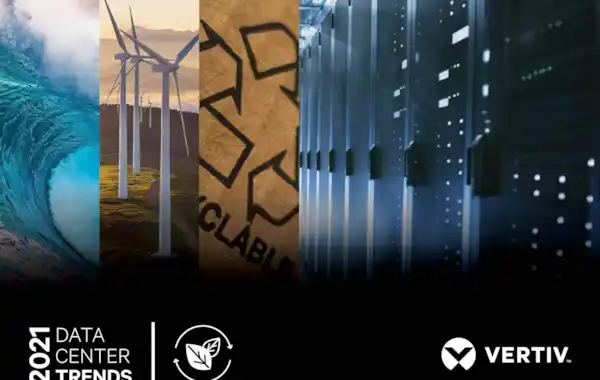01 April 2021
|
Nigel Gore, Global Offerings, High Density and Liquid Cooling at Vertiv looks at the future of liquid cooling
Liquid cooling has been around as a technology since the 1960s but has struggled to be widely adopted. Yet this is about to change. Current demands for IoT, artificial intelligence and machine learning, as well as edge applications, are placing new demands on data centres. To put this into perspective, Gartner has predicted that over one million IoT devices are expected to go into operation every hour in 2021.
It is crucial, therefore, that data centres are prepared to cope with these new levels of demand, running at maximum capacity while avoiding downtime. This means that data centres need to be designed and managed more efficiently to power a new generation of technologies. It is with this goal in mind that solutions such as liquid cooling have an important role to play.
Liquid is becoming the status quo
When it comes to cooling technologies, there is no ‘one size fits all’ approach. For example, geographical needs can determine priorities based on climatic conditions. There are a variety of cooling technologies out there – established and emerging. But liquid is becoming the preferred choice for effective and efficient heat capture and transport to manage temperatures in increasingly busy data centres. According to Omdia’s Data centre Thermal Management Report 2020, growth of forms of liquid cooling, like immersion, are expected to double between 2020 and 2024. Several factors are contributing to this shift, including edge growth, increasing rack densities, as well as new energy efficiency and sustainability requirements.
Pure water is being used to maximise data centre cooling as it has a heat transfer value of 4179 J/KgK, much higher than the value of air. These heat properties make liquid cooling an efficient option. And there are different forms of liquid cooling available to suit different needs, offering much needed flexibility. Liquid cooling can be implemented using one of these methods:
• The cold plated approach: this primarily captures heat from the processors, with new designs extending to other components of the server. This is typically used in conjunction with some form of additional air-cooling in most cases to support ancillary equipment.
• Immersion liquid cooling: this captures the vast majority of the server heat and as such reduces the demand on air-based cooling, including climate control and comfort cooling combined with efficient external heat rejection.
Liquid cooling can help businesses cope with unprecedented quantities of demand for compute power, making it hard to understand why it is yet to be widely adopted. It’s not that it is a questionable technology – the issue lies with the fact that, until relatively recently, there simply wasn’t the demand.
However, Omdia’s report shows that, in response to increasingly power-intensive compute requirements, data centre operators are now looking for ways to improve efficiency around cooling. At Vertiv, we have seen growing demand for liquid cooling deployments across our global customers in 2020. Businesses have started to take a more scientific approach to mapping out the components with the highest heat outputs; this includes networking equipment, telecommunications infrastructure, power delivery and data storage. Many of these devices are already installed in data centres globally, and the life cycle and specification of this equipment will determine the approach data centre managers take to liquid cooling.
Better to retrofit than never
Some data centres are equipped with legacy IT equipment designed for air cooling. Many of these are not viable for retrofit to liquid cooling, mainly due to the cost, labour overhead and level of conversion required. However, at times a move to liquid cooling to boost efficiency and environmental impact can be more cost effective than redesigning the entire facility. In this case it's best to install an air to liquid CDU as a first step before retrofitting the data centre. This will allow for a liquid cooled rack of servers utilising direct to chip cold plates to be deployed without a dedicated liquid loop taken through the data centre, and there is an added benefit of the liquid being controlled in smaller, more manageable volumes.
Retrofitting liquid cooling infrastructure can be a complex task. For data centre managers who need some guidance on best practice, our customers have found our partnerships with industry associations such as The Green Grid, ASHRAE and the Open Compute Project invaluable. These specialists can assist with considerations such as selecting construction materials that are compliant for use based on the chosen liquid cooling method. Another option is the development of prefabricated modular data centres, where a liquid cooled deployment could be added to a facility with speed, and without significant reconstruction. Ultimately, many data centres looking to boost their efficiency can be retrofitted for liquid cooling but finding optimal methods while following industry best practices and guidelines is key to achieving the right approach.
Improve your efficiency, and the environment
Data centre operators are under greater pressure to manage their environmental footprint, and new cooling technologies can help them achieve this. This has sparked some brilliantly inventive initiatives around the use of liquid cooling. For example, one concept saw the use of 5G network infrastructure deployed with liquid cooling within housing estates. Waste heat was repurposed for water heating, reducing the excess energy required for central heating within the houses.
Deployments of liquid cooling are growing in number, and it is ultimately what will help to take cooling infrastructure cooling to the next level. As the many business benefits of liquid cooling are realised, it’s highly likely that Omdia’s prediction of liquid cooling doubling in the next three years will come true. Liquid cooling will empower the data centre industry to continue attracting new customers looking to partner with more sustainable companies, as well as improving its own energy efficiency.








